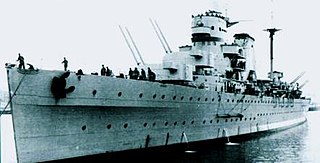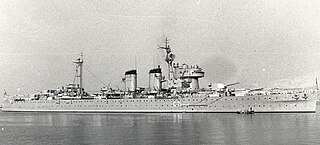
The Battle of Cape Palos, also known as the Second Battle of Cape Palos, was the biggest naval battle of the Spanish Civil War, fought on the night of March 5–6, 1938, east of Cape Palos near Cartagena, Spain.
The Battle of Cape Spartel was a naval battle of the Spanish Civil War that broke the Republican naval blockade of the Strait of Gibraltar, securing the maritime supply route to Spanish Morocco for the Nationalists early in the war. The action occurred on 29 September 1936 between two Nationalist cruisers and two Republican destroyers.

The Canarias class was a class of heavy cruiser of the Spanish Navy. Two ships of the class were completed in the 1930s. They were built in Spain by the Vickers-Armstrongs subsidiary Sociedad Española de Construcción Naval upon a British design, and were a modified version of the Royal Navy′s County class. The two ships completed, Canarias and Baleares, both saw service during the Spanish Civil War, the latter being sunk.

Sánchez Barcáiztegui was a Churruca-class destroyer of the Spanish Republican Navy. She took part in the Spanish Civil War on the side of the government of the Second Spanish Republic.

Almirante Ferrándiz was a Churruca-class destroyer in the Spanish Republican Navy. She took part in the Spanish Civil War on the government side.

Lepanto was a Churruca-class destroyer of the Spanish Republican Navy. She took part in the Spanish Civil War on the side of the government of the Second Spanish Republic. She was named after the Battle of Lepanto.

The Almirante Cervera class were three light cruisers built for the Spanish Navy in the 1920s. The ships were built by Sociedad Española de Construcción Naval in Ferrol which had strong British links and were designed by Sir Philip Watts. It has often been stated that the design was based on the British Emerald-class cruiser, but this seems not in fact to have been the case, although they were clearly an inspiration for the concept of the Spanish ships. The main armament comprised Vickers pattern 6-inch guns with single mountings in "A" and "Y" positions and twin turrets in "B", "Q" and "X" positions. The programme was initially authorised in 1915 but was delayed by World War I with construction of the first ship starting in 1917.

Júpiter-class minelayers was a group of four vessels of the Spanish Republican Navy built during the Spanish Republic. Three of them came into service during the Civil War after joining the rebel side.

José Luis Díez was a Churruca-class destroyer in the Spanish Republican Navy, in the Basque Auxiliary Navy section. She took part in the Spanish Civil War on the government side.

Canarias was a Canarias-class heavy cruiser of the Spanish Navy. She was built in Spain by the Vickers-Armstrongs subsidiary Sociedad Española de Construcción Naval based on a British design, being a modified version of the Royal Navy′s County class. Canarias saw service during the Spanish Civil War.

Baleares was a Canarias-class heavy cruiser of the Spanish Navy whose control was taken by the Nationalist side during the Spanish Civil War. The two ships of the class were built upon a British design and were a modified version of the Royal Navy′s County class. Baleares was constructed in Spain by the Vickers-Armstrongs subsidiary Sociedad Española de Construcción Naval, and saw service during the Spanish Civil War, when she was torpedoed and sunk by destroyers of the Spanish Republican Navy during the Battle of Cape Palos.

Mar Negro was an armed merchantman of the Nationalist Spanish Navy during the Spanish Civil War. The cargo ship was launched in 1930 along with her sister ship MV Mar Cantábrico, and after five years with the Compañía Marítima Del Nervión company, she was requisitioned by the Spanish Republican Navy in 1936. Captured by a group of Nationalist sympathizers from her crew off Algeria in 1937, she entered in service in 1938 after being converted to an auxiliary cruiser.

The Spanish Republican Navy was the naval arm of the Armed Forces of the Second Spanish Republic, the legally established government of Spain between 1931 and 1939.

Luis González de Ubieta y González del Campillo was an admiral of the Spanish Republican Navy during the Spanish Civil War. He died in exile as the captain of the Panamanian merchant vessel Chiriqui, refusing to be rescued when the ship under his command sank in the Caribbean Sea not far from Barranquilla.
Almirante Miranda (AM) was a Churruca-class destroyer that fought in the Spanish Civil War on the Republican side and, after the war, joined the post-war Spanish Navy. She was named after Admiral Augusto Miranda y Godoy, a Spanish Minister of the Navy.
Almirante Antequera (AA) was a 2nd series Churruca-class destroyer that fought on the Republican side during the Spanish Civil War and, after the war, joined the post-war Spanish Navy. She was named after Juan Bautista Antequera y Bobadilla, a vice admiral and Spanish Minister of the Navy.

Miguel de Cervantes was an Almirante Cervera-class light cruiser that served in the Spanish Navy. She fought in the Spanish Civil War on the Republican side, before joining the post-war Spanish Navy. She was ordered by a Royal Decree on 31 March 1926, as part of a naval construction project headed by Counter Admiral Honorio Cornejo.

Velasco was a Spanish Navy destroyer in commission from 1924 to 1957. She served in the Rif War in 1925 and fought on the Nationalist side during the Spanish Civil War of 1936–1939. While in commission, she served the Kingdom of Spain from 1924 to 1931, the Second Spanish Republic from 1931 to 1936, and the civil war's Nationalist faction and the Francoist Spanish State its victory established from 1936 to 1957.
















